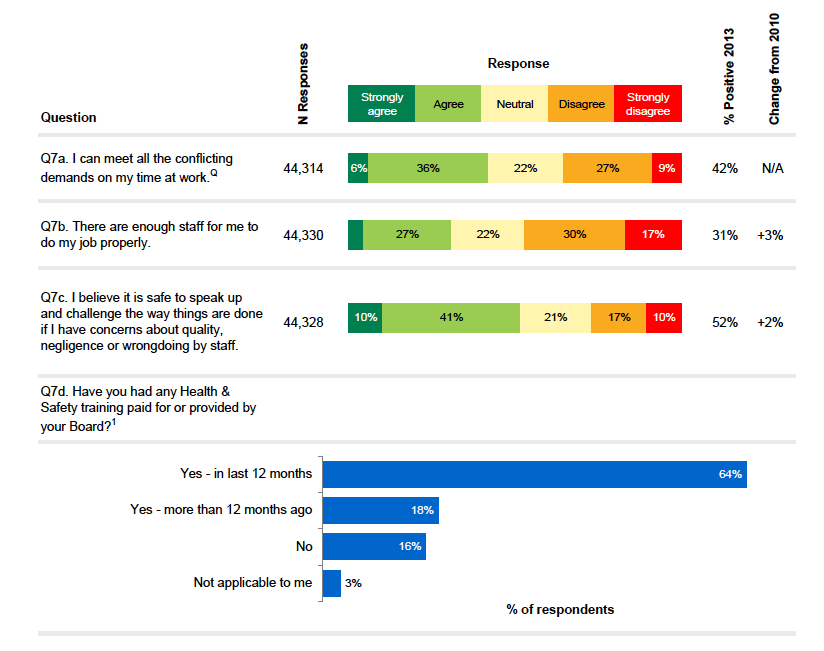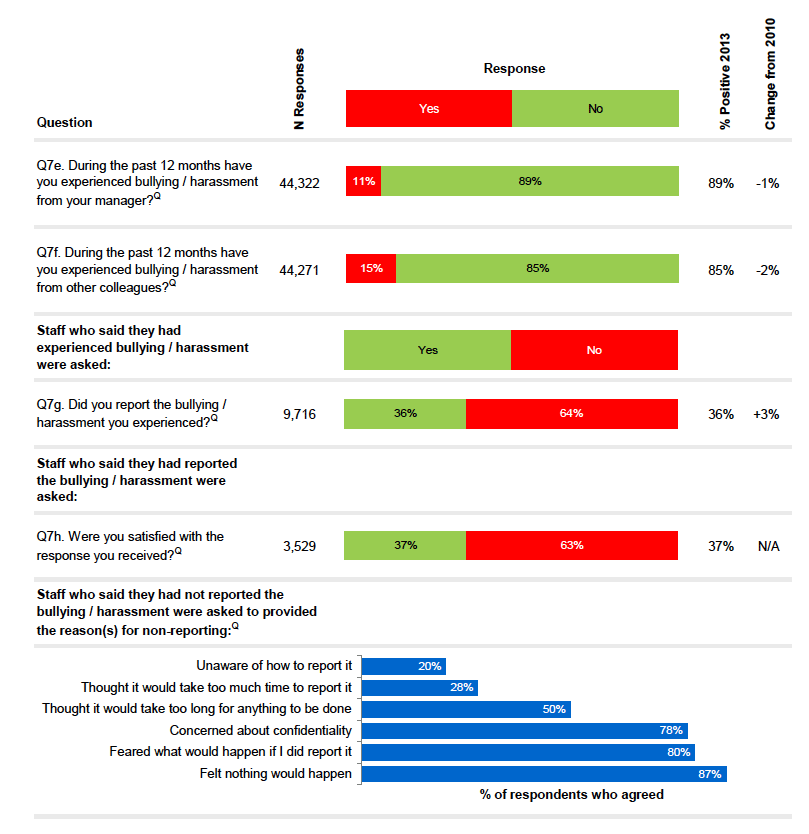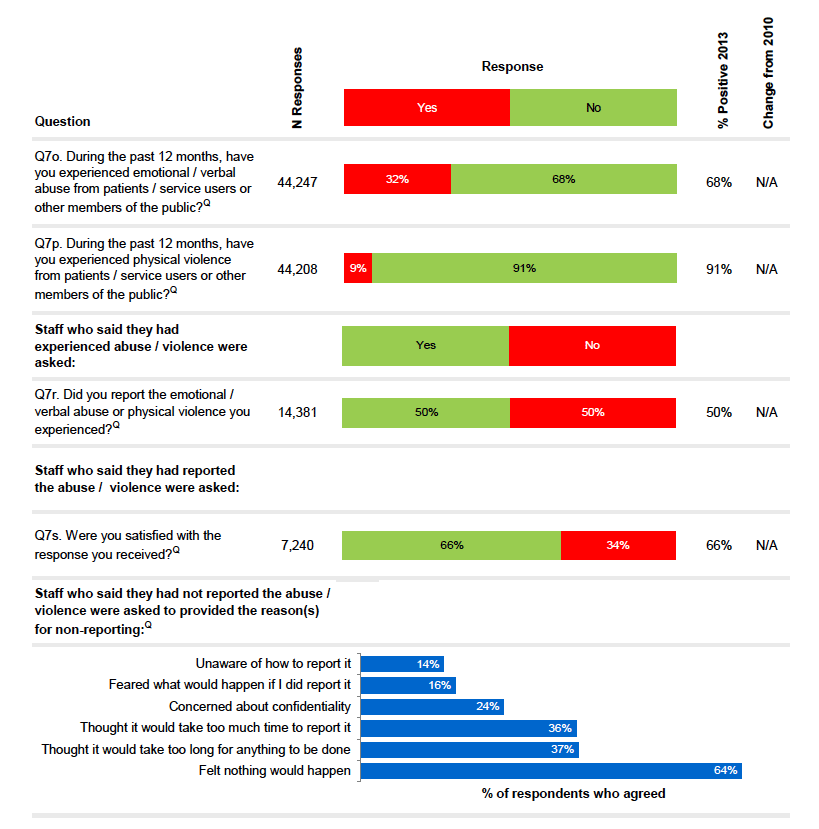NHSSCOTLAND STAFF SURVEY 2013 National Report
This National Report provides an overview of the results of the 2013 NHSScotland Staff Survey. The National Staff Survey gives all NHSScotland staff the opportunity to provide feedback on their experience of working for the organisation.
12. Provided with a continuously improving and safe working environment, promoting the health and wellbeing of staff, patients and the wider community
All staff should be provided with a safe working environment. Employers have a duty (and a legal requirement) to protect the health, safety and welfare of their employees in the workplace. The fifth element of the NHS Staff Governance Standard states that staff are to be 'Provided with a continuously improving and safe working environment, promoting the health and wellbeing of staff, patients and the wider community'. In this section of the survey, staff were asked for their views in relation to the above.
Two statements within this Staff Governance strand showed an improvement in percentage positive response in 2013 compared to 2010, see Table 7. The first of these was: 'I believe it is safe to speak up and challenge the way things are done if I have concerns about quality, negligence or wrongdoing by staff' (Q7c), which increased by two percentage points to 52%. The second was: 'There are enough staff for me to do my job properly' (Q7b), which received a positive response from 31% of survey respondents in 2013 (up three percentage points on 2010). Due to a change in question wording in 2013, direct comparison with 2010 is not possible for Q7a 'I can meet all the conflicting demands on my time at work' (see details in Appendix F).
Across NHS Boards, there was a range in the percentage of positive responses for these three questions (see details in Appendix B). Executive Grades/Senior Managers who responded to the survey were the most likely to agree 'I believe it is safe to speak up and challenge the way things are done if I have concerns about quality, negligence or wrongdoing by staff' (76%) and Ambulance Vehicle Crew who responded to the survey the least likely to do so (28%). Medical/Dental Support staff who responded to the survey were the most likely to agree 'There are enough staff for me to do my job properly' (46%). Ambulance Management staff who responded were the least likely to agree with this previous statement (11%) and also the least likely to agree 'I can meet all the conflicting demands on my time at work' (see details in Appendix C).
Table 7 also shows that more than eight out of ten staff who responded to the survey said they had received health and safety training paid for or provided by their NHS Board. This was two percentage points higher than reported in 2010. Across NHS Boards, this ranged from 53% to 95% (see Appendix B). Qualified/Registered AHP (Allied Health Profession) staff who responded to the survey were the most likely to have undertaken such training (93%) and Ambulance EMDC staff the least likely to have done so (19%), see Appendix C.
In summary, the two statements in this section for which comparisons could be made with the 2010 survey (Q7c and Q7b) both showed a small (plus two and plus three) percentage points increase in positive response in 2013. More than eight out of ten staff who responded to the survey had undertaken health and safety training that was paid for or provided by their Board and this too was higher than in 2010.
Table 7: Response to questions relating to the 'Provided with a Continuously Improving and Safe Working Environment' Staff Governance dimension.

1 Of the respondents to which this question was applicable, 84% indicated that they had received Health & Safety training, either within the last 12 months or more than 12 months ago. In the 2010 survey the equivalent percentage was 82%.
Q Indicates a change in question wording from 2010 survey.
N/A Indicates that direct comparison with 2010 was not possible.
12.1 Bullying/harassment
In the survey, staff were asked if they had experienced bullying/harassment in the past 12 months from their manager or from other colleagues. Table 8 shows that, 11% of staff who responded to the survey said that they had experienced bullying/harassment from their manager (Q7e) and 15% of respondents said that they had experienced bullying/harassment from other colleagues (Q7f). In both cases, there was a slight increase in the percentage of respondents experiencing bullying and harassment compared to 2010. When interpreting this difference please note that there was a change in the format of these questions between 2013 and 2010 (see Table 8 footnotes for more details).
The percentage of respondents who had experienced bullying/harassment from their manager or from other colleagues in the past 12 months varied across NHS Boards: between 5% and 26% for the former and between 11% and 30% for the latter (see Appendix B for more details).
Maintenance/Estates staff who responded to the survey along with Ambulance Vehicle Crew were the most likely to say that they had experienced bullying/harassment from their manager (18%). Doctors in training were the least likely to do so (4%). Ambulance Vehicle Crew who responded to the survey were the most likely to say that they had experienced this from other colleagues (23%), whilst the least likely to do so (9%) were respondents from the Other Personal & Social Care staff group (see Appendix C for more details).
Of those respondents who said that they had experienced bullying/harassment, 36% said they had reported it (Q7g). This was three percentage points higher than the level of reporting in 2010, however it should be noted that the wording of this question changed slightly in 2013. Across NHS Boards, the level of reporting ranged from 26% to 46% (see Appendix B for more details). The most commonly identified reasons for non-reporting were: 'I felt nothing would happen' (87%); 'I feared what would happen if I did report it' (80%) and 'I was concerned about confidentiality' (78%), see Table 8.
Less than four in ten respondents who reported the bullying/harassment they experienced were satisfied with the response they received.
In summary, of the staff responding to the survey, a small but notable percentage reported that they had experienced bullying/harassment in the past 12 months from their manager and/or from other colleagues. In both cases, this was a slight increase when compared to 2010. The level of reporting of bullying/harassment increased slightly in 2013, although remained below 40%. Of those who did report the bullying/harassment they experienced, less than 40% were satisfied with the response they received. The most commonly identified reasons for not reporting the bullying/harassment were because respondents felt that nothing would happen, they feared what would happen if they did report it and/or they had concerns about confidentiality.
Table 8: Response to questions relating to bullying and harassment.

Q Indicates a change in question wording from 2010 survey. In the 2010 survey, Q7e and Q7f were covered by one two-part question. Part 1 asked staff if they had experienced bullying or harassment in the past 12 months while working for their Board. Part 2 asked them to identify, from a list of response options, the source(s) of the bullying/harassment. The 2010 comparison figures have been derived from an analysis of the results from these two questions combined (see Appendix F for more details).
N/A Indicates that direct comparison with 2010 was not possible.
12.2 Emotional/verbal abuse and physical violence
In the survey, staff were asked if they had experienced emotional/verbal abuse and/or physical violence from patients/service users or other members of the public in the past 12 months. Table 9 shows that, approximately one in three staff who responded to the survey said that they had experienced 'emotional/verbal abuse' (Q7o) and approximately one in ten had experienced 'physical violence' (Q7p). Nine per cent of respondents who experienced abuse or violence described it as 'discriminatory' in nature. Comparable 2010 data were not available for any of the questions in this section (see Appendix F for more details).
Of those respondents who said they had experienced abuse or violence, half had reported it (Q7r). Two out of three staff who had reported the abuse/violence were satisfied with the response received (Q7s). For those who had failed to report, most commonly this was because they 'felt nothing would happen'.
There was variation between NHS Boards, particularly the Special Boards, in the percentage of respondents who said that they had experienced emotional/verbal abuse or physical violence in the past 12 months from patients, service users or other members of the public (see details in Appendix B). The level of reporting also varied widely across Boards.
Ambulance EMDC staff who responded to the survey were the most likely to say that they had experienced emotional or verbal abuse from patients/service users or the public in the past 12 months (75%) and Health Promotion staff the least likely to do so (10%). Ambulance Vehicle Crew who responded to the survey were the most likely to say that they had experienced physical violence from patients/service users or the public in the past 12 months (31%), see Appendix C for more details.
In summary, of the staff responding to the survey, a small but notable percentage reported that they had experienced physical violence in the past 12 months and approximately one third of respondents stated that they had experienced emotional/verbal abuse. Half of those who had experienced abuse/violence had reported it. Two thirds of those who reported the abuse/violence they experienced said that they were satisfied with the response. The most common reason for non-reporting was because respondents felt that nothing would happen if they did report it.
Table 9: Response to questions relating to emotional / verbal abuse and physical violence.1

1 Of the respondents who experienced abuse and/or violence, 9% reported that it was discriminatory in nature. This question (Q7q) was not asked in 2010.
Q Indicates a change in question wording from 2010 survey.
N/A Indicates that direct comparison with 2010 was not possible.
Contact
Email: Malcolm Summers
There is a problem
Thanks for your feedback